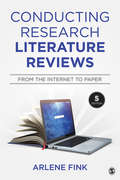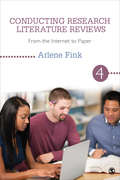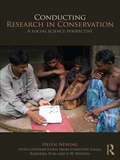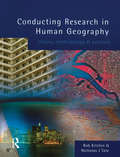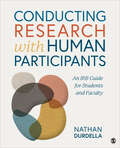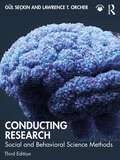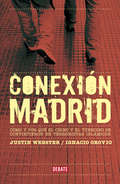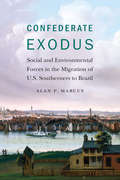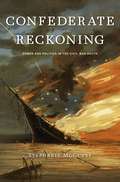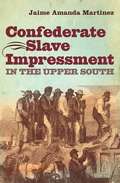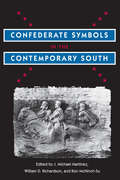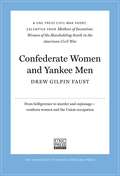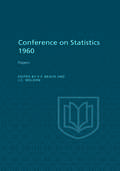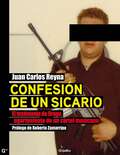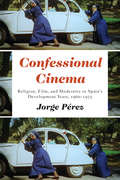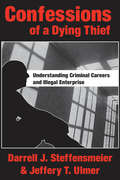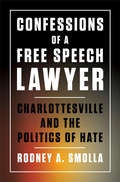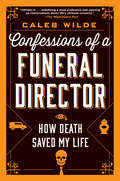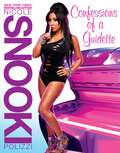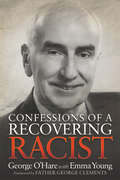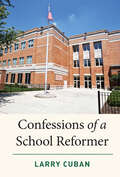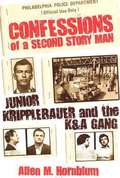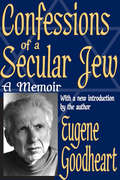- Table View
- List View
Conducting Research Literature Reviews: From the Internet to Paper
by Arlene G. FinkProviding readers with an accessible, in-depth look at how to synthesize research literature, Conducting Research Literature Reviews: From the Internet to Paper is perfect for students, researchers, marketers, planners, and policymakers who design and manage public and private agencies, conduct research studies, and prepare strategic plans and grant proposals. Bestselling author Arlene Fink shows readers how to explain the need for and significance of research, as well as how to explain a study’s findings. Offering a step-by-step approach to conducting literature reviews, the Fifth Edition features new research, examples, and references from the social, behavioral, and health sciences, expanded coverage of qualitative research, updated and revised meta-analysis procedures, a brand new glossary of key terms, double the number of exercises, and additional examples of how to write reviews.
Conducting Research Literature Reviews: From the Internet to Paper
by Dr Arlene G. FinkProviding readers with an accessible, in-depth look at how to synthesize research literature, Conducting Research Literature Reviews is perfect for students, researchers, marketers, planners, and policymakers who design and manage public and private agencies, conduct research studies, and prepare strategic plans and grant proposals. Bestselling author Arlene Fink shows readers how to explain the need for and significance of research, as well as how to explain a study’s findings. Offering a step-by-step approach to conducting literature reviews, the Fourth Edition features updated examples and covers: how to select databases and evaluate their quality; selecting and organizing key words and other terms in order to effectively search databases and the Web; setting standards for evaluating the quality of research and other literature; extracting and recording information from articles and studies; synthesizing what the reader finds either descriptively or via a meta-analysis; recording and storing the results in a virtual file cabinet; and how to use bibliographic software.
Conducting Research in Conservation: Social Science Methods and Practice
by Helen NewingConducting Research in Conservation is the first textbook on social science research methods written specifically for use in the expanding and increasingly multidisciplinary field of environmental conservation. The first section on planning a research project includes chapters on the need for social science research in conservation, defining a research topic, methodology, and sampling. Section two focuses on practical issues in carrying out fieldwork with local communities, from fieldwork preparation and data collection to the relationships between the researcher and the study community. Section three provides an in-depth focus on a range of social science methods including standard qualitative and quantitative methods such as participant observation, interviewing and questionnaires, and more advanced methods, such as ethnobiological methods for documenting local environmental knowledge and change, and participatory methods such as the ‘PRA’ toolbox. Section four then demonstrates how to analyze social science data qualitatively and quantitatively; and the final section outlines the writing-up process and what should happen after the end of the formal research project. This book is a comprehensive and accessible guide to social science research methods for students of conservation related subjects and practitioners trained in the natural sciences. It features practical worldwide examples of conservation-related research in different ecosystems such as forests; grasslands; marine and riverine systems; and farmland. Boxes provide definitions of key terms, practical tips, and brief narratives from students and practitioners describe the practical issues that they have faced in the field.
Conducting Research in Human Geography: Theory, Methodology and Practice
by Rob Kitchin Nick TateReading this book is your first step to becoming a competent human geography researcher. Whether you are a novice needing practical help for your first piece of research or a professional in search of an accessible guide to best practice, Conducting Research in Human Geography is a unique and indispensable book to have at hand.The book provides a broad overview of theoretical underpinnings in contemporary human geography and links these with the main research methodologies currently being used. It is designed to guide the user through the complete research process, whether it be a one day field study or a large project, from the nurturing of ideas and development of a proposal, to the design of an enquiry, the generation and analysis of data, to the drawing of conclusions and the presentation of findings.
Conducting Research with Human Participants: An IRB Guide for Students and Faculty
by Nathan Richard DurdellaConducting Research with Human Participants: An IRB Guide for Students and Faculty by Nathan Durdella is the only guidebook students and faculty will need to navigate the IRB process and secure swift approval of research protocols. This book serves as an advisor to walk researchers through all the details of drafting, submission, and revision of materials for Institutional Review Boards so they can complete their research projects or dissertations faster. This text walks readers through the history of Institutional Review Boards, the contemporary context of ethical research, strategies to effectively draft, submit, and revise an IRB protocol, and guidance on working with an approved protocol in the field. The latest updates to the Common Rule and other regulatory frameworks, including special protections for working with vulnerable groups, are covered throughout the text. Not every research project goes according to plan, so adverse events and reporting receive special coverage. A final chapter on ethical research practices beyond IRB compliance encourages researchers to think through how to exit the field of research and ensure their research benefits the individuals, families, and communities in which they work. Take the guesswork out of the IRB process from start to finish with this handy guide.
Conducting Research with Human Participants: An IRB Guide for Students and Faculty
by Nathan Richard DurdellaConducting Research with Human Participants: An IRB Guide for Students and Faculty by Nathan Durdella is the only guidebook students and faculty will need to navigate the IRB process and secure swift approval of research protocols. This book serves as an advisor to walk researchers through all the details of drafting, submission, and revision of materials for Institutional Review Boards so they can complete their research projects or dissertations faster. This text walks readers through the history of Institutional Review Boards, the contemporary context of ethical research, strategies to effectively draft, submit, and revise an IRB protocol, and guidance on working with an approved protocol in the field. The latest updates to the Common Rule and other regulatory frameworks, including special protections for working with vulnerable groups, are covered throughout the text. Not every research project goes according to plan, so adverse events and reporting receive special coverage. A final chapter on ethical research practices beyond IRB compliance encourages researchers to think through how to exit the field of research and ensure their research benefits the individuals, families, and communities in which they work. Take the guesswork out of the IRB process from start to finish with this handy guide.
Conducting Research: Social and Behavioral Science Methods
by Gül Seçkin Lawrence T. OrcherConducting Research prepares students to conduct their first empirical research study, with quantitative and qualitative methods covered in detail. The emphasis is on providing practical, easy-to-follow advice on how to conduct a first research project.This book walks students through each step of the research process, from selecting a research topic and participants to analysing data and presenting research findings. Notably, the third edition places a heightened emphasis on digital social science research methods, encompassing both quantitative and qualitative methodological approaches. The primary focus is on providing practical and easily comprehensible guidance for successfully executing an empirical project for a research methods and design course. The updated real research examples serve to exemplify the application of research principles in an empirical social science research context, further enhancing the students' preparedness for their research project. Furthermore, the inclusion of enhanced online resources for both students and instructors renders this an ideal text for social sciences courses in multiple disciplines such as sociology, psychology, education and healthcare.With online resources for students and instructors, this is the ideal text across the social sciences, such as sociology, psychology, healthcare and education.New to this edition: A new chapter on digital social science methods incorporating both quantitative and qualitative research methodologies A new chapter on research ethics to support the foundations of research knowledge All-new support materials available online for instructors and students
Conexión Madrid
by Ignacio Orovio Monreal Justin WebsterDurante dos años y medio, el periodista Ignacio Orovio y el documentalista Justin Webster, han analizado más de 100.000 páginas de documentos jurídicos, han entrevistado a fuentes directas y han viajado a Marruecos, Túnez, Turquía, Holanda e Inglaterra, con el propósito de reconstruir las trayectorias de los dos líderes del grupo islamista que atentó contra varios trenes de cercanias el 11 de marzo de 2004. Después de lanzar un premiado documental producido por la BBC, lograron reunir más información para publicar esta profunda investigación sobre el atentado más sangriento realizado por el fundamentalismo islámico en suelo europeo.
Confederacy of Silence: A True Tale of the New Old South
by Richard RubinDiscussion of the New South by a news correspondent on a Southern paper.
Confederate Exodus: Social and Environmental Forces in the Migration of U.S. Southerners to Brazil
by Alan P. MarcusWhile Americans have been deeply absorbed with the topic of immigration for generations, emigration from the United States has been almost entirely ignored. Following the U.S. Civil War an estimated ten thousand Confederates left the U.S. South, most of them moving to Brazil, where they became known as &“Confederados,&” Portuguese for &“Confederates.&” These Southerners were the largest organized group of white Americans to ever voluntarily emigrate from the United States. In Confederate Exodus Alan P. Marcus examines the various factors that motivated this exodus, including the maneuvering of various political leaders, communities, and institutions as well as agro-economic and commercial opportunities in Brazil. Marcus considers Brazilian immigration policies, capitalism, the importance of trade and commerce, and race as salient dimensions. He also provides a new synthesis for interpreting the Confederado story and for understanding the impact of the various stakeholders who encouraged, aided, promoted, financed, and facilitated this broader emigration from the U.S. South.
Confederate Reckoning: Power and Politics in the Civil War South
by Stephanie McCurryPulitzer Prize Finalist Winner of the Frederick Douglass Prize Winner of the Merle Curti Prize “Perhaps the highest praise one can offer McCurry’s work is to say that once we look through her eyes, it will become almost impossible to believe that we ever saw or thought otherwise.”—Drew Gilpin Faust, The New Republic The story of the Confederate States of America, the proslavery, antidemocratic nation created by white Southern slaveholders to protect their property, has been told many times in heroic and martial narratives. Now, however, Stephanie McCurry tells a very different tale of the Confederate experience. When the grandiosity of Southerners’ national ambitions met the harsh realities of wartime crises, unintended consequences ensued. Although Southern statesmen and generals had built the most powerful slave regime in the Western world, they had excluded the majority of their own people—white women and slaves—and thereby sowed the seeds of their demise. Wartime scarcity of food, labor, and soldiers tested the Confederate vision at every point and created domestic crises to match those found on the battlefields. Women and slaves became critical political actors as they contested government enlistment and tax and welfare policies, and struggled for their freedom. The attempt to repress a majority of its own population backfired on the Confederate States of America as the disenfranchised demanded to be counted and considered in the great struggle over slavery, emancipation, democracy, and nationhood. That Confederate struggle played out in a highly charged international arena. The political project of the Confederacy was tried by its own people and failed. The government was forced to become accountable to women and slaves, provoking an astounding transformation of the slaveholders’ state. Confederate Reckoning is the startling story of this epic political battle in which women and slaves helped to decide the fate of the Confederacy and the outcome of the Civil War.
Confederate Slave Impressment in the Upper South
by Jaime Amanda MartinezUnder policies instituted by the Confederacy, white Virginians and North Carolinians surrendered control over portions of their slave populations to state authorities, military officials, and the national government to defend their new nation. State and local officials cooperated with the Confederate War Department and Engineer Bureau, as well as individual generals, to ensure a supply of slave labor on fortifications. Using the implementation of this policy in the Upper South as a window into the workings of the Confederacy, Jaime Amanda Martinez provides a social and political history of slave impressment. She challenges the assumption that the conduct of the program, and the resistance it engendered, was an indication of weakness and highlights instead how the strong governments of the states contributed to the war effort.According to Martinez, slave impressment, which mirrored Confederate governance as a whole, became increasingly centralized, demonstrating the efficacy of federalism within the CSA. She argues that the ability of local, state, and national governments to cooperate and enforce unpopular impressment laws indicates the overall strength of the Confederate government as it struggled to enforce its independence.
Confederate Symbols in the Contemporary South
by J. Michael Martinez, William D. Richardson, and Ron McNinch-SuA timely collection of essays examining the controversy surrounding the use & display of Confederate symbols in the modern South.
Confederate Women and Yankee Men
by Drew Gilpin FaustWhen Confederate men marched off to battle, southern women struggled with the new responsibilities of directing farms and plantations, providing for families, and supervising increasingly restive slaves. Drew Gilpin Faust offers a compelling picture of the more than half-million women who belonged to the slaveholding families of the Confederacy during this period of acute crisis, when every part of these women's lives became vexed and uncertain.In this UNC Press Short, excerpted from Mother's of Invention: Women of the Slaveholding South in the American Civil War, Drew Gilpin Faust explores the legendary hostility of Confederate women toward Yankee soldiers. From daily acts of belligerence to murder and espionage, these women struggled not only with the Yankee enemy in their midst but with the genteel ideal of white womanhood that was at odds with their wartime acts of resistance. UNC Press Civil War Shorts excerpt compelling, shorter narratives from selected best-selling books published by the University of North Carolina Press and present them as engaging, quick reads. Produced exclusively in ebook format, these shorts present essential concepts, defining moments, and concise introductions to topics. They are intended to stir the imagination and encourage further exploration of the original publications from which these works are drawn.
Conference on Statistics 1960
by J. C. Weldon E. F. BeachIn 1958 the Canadian Political Science Association established a committee to look into ways and means of improving statistical research in the social sciences in Canada. One of the ways in which the committee thought this could be done was by establishing an annual forum where papers could be presented and discussed. Eight papers given at the first Conference at Queen's University are contained in this volume. Diverse alike in subject and statistical method---as indeed a collection of papers reflecting the purpose of the founding committee is bound to be---the papers as printed incorporate the discussion that attended their presentation in 1960.The papers are: K.A.H. Buckley, "Historical Estimates of Internal Migration in Canada,"; Richard E. Du Wurs, Robert Batson, Margaret Daffron, "The 'Mass Society' and 'Community' Analyses of the Social Present"; P.J. Giffen, "Canadian Criminal Statistics"; E.J. Hanson, "The Post-war Rise of the Crude Petroleum Industry"; Gideon Rosenbluth, "Salaries of Engineers and Scientists, 1951"; David N. Solomon, Agnes M. Fergusson, "The Distribution and Functions of Canadian Engineers and Scientists"; K.W. Studnicki-Gizbert, "The Structure and Growth of the Canadian Air Transport Industry"; T.R. Vout, "The Canadian Manufacturing Industry, 1900-57."
Confesión de un sicario: El testimonio de Drago, lugarteniente de un cártel mexicano
by Juan Carlos ReynaUn impactante testimonio, narrado por un sicario ("Drago"), al periodista Juan Carlos Reyna. Este no es un libro de ficción, sino las memorias de un asesino a sueldo del narcotráfico. "Lo único que sé hacer es matar." Con esta frase comienza la confesión de Drago, quien fuera primero sicario y lugarteniente de un importante cártel mexicano, y después miembro del Programa de Testigos Protegidos de la Procuraduría General de la República. Confesión de un sicario, escrito por el periodista Juan Carlos Reyna a partir de las entrevistas que le realizó a Drago y del testimonio escrito de éste, es un libro aterrador y doloroso que narra de primera mano la realidad más descompuesta de México: el mundo del narcotráfico en todos sus niveles y la corrupción de todos los sectores del gobierno. Este libro, que está llamado a convertirse en un clásico de nuestro tiempo, es además un recuento doloroso de traiciones, carencias, violacionesy asesinatos, un verdadero descenso hacia el infierno, pues como dice Reyna en el epílogo: "Durante nuestros encuentros intenté acompañar en su descenso a Drago, quien desde nuestra primera reunión, a la que llegó vestido de traje y en la que se descamisó para enseñarme las heridas de bala acumuladas a lo largo de su vida, me habló minuciosamente de sus ejecuciones, me aseguró sufrir ataques de depresión e insomnio y me pidió que lo llamara con el sobrenombre utilizado aquí pues en su infancia escuchó el mito de un dragón que descendía a los infiernos, donde moría para luego renacer".
Confessional Cinema: Religion, Film, and Modernity in Spain’s Development Years, 1960–1975
by Jorge PerezIn Confessional Cinema, Jorge Pérez analyzes how cinema engaged the shifting role of religion during the last fifteen years of Francisco Franco’s dictatorship. Pérez interrogates the assumption that after 1957, when the Franco regime recast itself in a secular and modernizing fashion, religion vanished from the cultural field. Instead, Spanish cinema addressed the transformation within Spanish Catholicism following Vatican II and Spain’s modernization processes. Confessional Cinema offers the first analysis of a neglected body of Spanish films, "nun films," which focus on the active role of religious women in the transformation of Spanish Catholicism. Pérez argues that commercial films, despite being less aesthetically accomplished, delved more than oppositional, art-house films into the fluctuating zeitgeist of the development years regarding the transformations within Spanish Catholicism. Confessional Cinema offers a provocative and original analysis of the significance of religion not from a theological point of view, but rather as a socio-political force and cultural determinant in the Spanish public sphere of this period, known as desarrollismo (development years) from 1960-1975.
Confessions of a Dying Thief
by Darrell J. Steffensmeier*Recipient of the American Society of Criminology's 2006 Michael J. Hindelang Award for a book, published within the past three calendar years, that is "the most outstanding contribution to research in criminology." *Nominated for the 2007 Outstanding Book Award of the Academy of Criminal Justice Sciences. Sam Goodman, was a long-time thief, fence, and quasi-legitimate businessman. He had a criminal career that spanned fifty years, beginning in his mid-teens and ending with his death when he was in his mid-sixties. Confessions of a Dying Thief is an in-depth ethnographic study of Sam and his world based on continuous contact with him for many years, on multiple interviews with his network of associates in crime and business, and on a series of interviews with him shortly before he died.The book updates and greatly expands the case study of Sam Goodman's fencing activity found in Steffensmeier's award-winning 1986 book The Fence: In the Shadow of Two Worlds. It combines Sam's colorful narrative accounts with substantive commentary by the authors to provide a more nuanced portrayal of criminal careers, illegal enterprise, and the broad landscape comprising the entity called "crime." To more fully understand pathways into and out of crime as well as the social organization of illegal enterprise, the authors propose an integrative learning-opportunity-commitment framework that combines differential association/social learning theory and an extended conceptualization of criminal opportunity with a three-fold theory of commitment to crime. This framework offers an integrated and more complete way of understanding mechanisms that underlie criminal offending and criminal careers. It also recognizes the complexity and scope of the criminal landscape and its embeddedness in the fabric of the larger society, including its criminal justice system.Sam's illness and death are a sobering backdrop th
Confessions of a Free Speech Lawyer: Charlottesville and the Politics of Hate
by Rodney A. SmollaIn the personal and frank Confessions of a Free Speech Lawyer, Rodney A. Smolla offers an insider's view on the violent confrontations in Charlottesville during the "summer of hate." Blending memoir, courtroom drama, and a consideration of the unhealed wound of racism in our society, he shines a light on the conflict between the value of free speech and the protection of civil rights.Smolla has spent his career in the thick of these tempestuous and fraught issues, from acting as lead counsel in a famous Supreme Court decision challenging Virginia's law against burning crosses, to serving as co-counsel in a libel suit brought by a fraternity against Rolling Stone magazine for publishing an article alleging that one of the fraternity's initiation rituals included gang rape. Smolla has also been active as a university leader, serving as dean of three law schools and president of one and railing against hate speech and sexual assault on US campuses.Well before the tiki torches cast their ominous shadows across the nation, the city of Charlottesville sought to relocate the Unite the Right rally; Smolla was approached to represent the alt-right groups. Though he declined, he came to wonder what his history of advocacy had wrought. Feeling unsettlingly complicit, he joined the Charlottesville Task Force, and he realized that the events that transpired there had meaning and resonance far beyond a singular time and place. Why, he wonders, has one of our foundational rights created a land in which such tragic clashes happen all too frequently?
Confessions of a Funeral Director: How Death Saved My Life
by Caleb Wilde“Wise, vulnerable, and surprisingly relatable . . . funny in all the right places and enormously helpful throughout. It will change how you think about death.” —Rachel Held Evans, New York Times–bestselling author of Searching for SundayWe are a people who deeply fear death. While humans are biologically wired to evade death for as long as possible, we have become too adept at hiding from it, vilifying it, and—when it can be avoided no longer—letting the professionals take over.Sixth-generation funeral director Caleb Wilde understands this reticence and fear. He had planned to get as far away from the family business as possible. He wanted to make a difference in the world, and how could he do that if all the people he worked with were . . . dead? Slowly, he discovered that caring for the deceased and their loved ones was making a difference—in other people’s lives to be sure, but it also seemed to be saving his own. A spirituality of death began to emerge as he observed the family who lovingly dressed their deceased father for his burial; the nursing home that honored a woman’s life by standing in procession as her body was taken away; the funeral that united a conflicted community. Through stories like these, told with equal parts humor and poignancy, Wilde’s candid memoir offers an intimate look into the business of death and a new perspective on living and dying.“Open[s] up conversations about life’s ultimate concerns.” —The Washington Post“As a look behind the closed doors of the death industry, as well as a candid exploration of Wilde’s own faith journey, this book is fascinating and compelling.” —National Catholic Reporter“[A] stunner of a debut.” —Rachel Held Evans, author of Inspired
Confessions of a Guidette
by Nicole "Snooki" PolizziAmerica’s favorite pint-sized party girl and star of MTV’s Jersey Shore follows up her New York Times bestselling novel A Shore Thing with this lighthearted, full-color, guide to being a guidette—a must-have for her legions of fans. Your mission, should you choose to accept it, is to arm yourself with bronzer, a tease comb, and makeup brushes and join the Snooki Style Revolution. When guidettes march in, people notice. It&’s the attitude. The boldness. The sex appeal. The tan. The serious shortage of hairspray in the surrounding area. You have to experiment in life, or you&’ll be boring. From Nicole &“Snooki&” Polizzi&’s top twenty-five rules for being a guidette, to her smushable makeup and skin secrets, to her rules on Snookin&’ for love, Snooki&’s sickest tips and advice for friggin&’ owning it are all here, along with hundreds of full color photographs and the official Snictionary for easy reference. But that&’s not all. There&’s a lot more to the diminutive reality star than what you see on TV. Snooki shares her obsessions (her bed, Viva Glam Gaga bright pink lipstick, sci-fi movies) and some juicy behind-the-Shore secrets (which season was her favorite, what it was like to wake up in a jail cell in season two, why the house smells like alcohol and dog&’s butt). For everything else, you&’ll just have to read the book! Being a guidette princess is about being yourself, doing what you want, and trying to have a good time wherever you are. So strap yourselves in, bitches! And get ready for the ride.
Confessions of a Recovering Racist
by Emma Young George O’HareThe memoir of a dyed-in-the-wool racist forced to change his beliefs to succeed in the progressively changing times of twentieth-century America. This true story is about George O&’Hare and his upbringing in a segregated, White, Irish Catholic, Chicago neighborhood. As an adult moving up the corporate ladder at a time when America was transitioning from Jim Crow to Civil Rights, George was asked by his manager to join the Junior Chamber of Commerce, which often worked closely with a race of people he did not want to know and did not trust. Consequently, George was faced with a dilemma. How could he be a part of this organization and fulfill his hopes of corporate success given the beliefs and principles he was taught as a child and had embraced his entire life? The path George ultimately chose to follow shaped and changed his life forever. He met some of the most iconic African Americans in the country and became good friends with Dr. Martin Luther King, comedian Dick Gregory, Father George Clements, Muhammad Ali, State Senator Barack Obama, and many others. This compelling memoir is also an historical document, giving insight into the heart of America during one of the most momentous eras in history. It is a must-read for anyone willing to look at George&’s life, examine one&’s own, and decide like George what each of us can do in our own small world and for our nation.
Confessions of a School Reformer
by Larry CubanIn Confessions of a School Reformer, eminent historian of education Larry Cuban reflects on nearly a century of education reforms and his experiences with them as a student, educator, and administrator.Cuban begins his own story in the 1930s, when he entered first grade at a Pittsburgh public school, the youngest son of Russian immigrants who placed great stock in the promises of education. With a keen historian's eye, Cuban expands his personal narrative to analyze the overlapping social, political, and economic movements that have attempted to influence public schooling in the United States since the beginning of the twentieth century. He documents how education both has and has not been altered by the efforts of the Progressive Era of the first half of the twentieth century, the Civil Rights Movement of the 1950s through the 1970s, and the standards-based school reform movement of the 1980s through today.Cuban points out how these dissimilar movements nevertheless shared a belief that school change could promote student success and also forge a path toward a stronger economy and a more equitable society. He relates the triumphs of these school reform efforts as well as more modest successes and unintended outcomes.Interwoven with Cuban's evaluations and remembrances are his "confessions," in which he accounts for the beliefs he held and later rejected, as well as mistakes and areas of weakness that he has found in his own ideology. Ultimately, Cuban remarks with a tempered optimism on what schools can and cannot do in American democracy.
Confessions of a Second Story Man: Junior Kripplebauer and the K&A Gang
by Allen M. HornblumFrom the 1950s to the 1970s, from Bar Harbor to Boca Raton, the ragtag crew known as the K&A Gang robbed wealthy suburban neighborhoods with assembly line skills. It was hard to imagine a more unlikely crew of successful thieves, writes Allen Hornblum. [They were] two-fisted, beer-guzzling, ear- and nose-biting hoodlums from a blue collar section of Philadelphia called Kensington. The gang infuriated homeowners up and down the East Coast, while baffling police. Confessions of a Second Story Man follows the gang as they move in and out of homes, courtrooms, and prisons, and even go on the run. Hornblum describes the transformation of the K&A Gang from a group of blue collar thieves to their work in conjunction with numerous organized crime families and their role in making Philadelphia the meth capitol of the nation. It is a compelling read about a fascinating bunch of hoodlums.
Confessions of a Secular Jew: A Memoir
by Eugene GoodheartWhat it means to be a Jew lies at the very heart of Confessions of a Secular Jew, a provocative memoir and a thoughtful speculation on the nature of Jewish identity and experience in an increasingly secular world. The legacy bequeathed to Eugene Goodheart was a "progressive" secular Yiddish education which identifi ed Jewish struggles against oppression with working class struggles against exploitation. In the vanguard was the Soviet Union. Goodheart's heroes were Moses, Bar Kochbah, Judah Maccabee, Karl Marx and that strange honorary Jew, Joseph Stalin, whose anti-Semitism would later become known to the world. Confessions of a Secular Jew is the story of Goodheart's disillusionment with the naive, even false, progressivism of that education. At the same time, it is an attempt to rescue and come to grips with the positive remains of that education and heritage.
